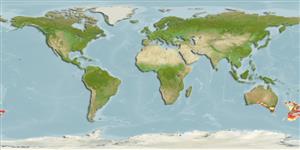Elasmobranchii (haaien en roggen) (sharks and rays) >
Squaliformes (Sleeper and dogfish sharks) >
Oxynotidae (Rough sharks)
Etymology: Oxynotus: oxys (Gr.), sharp; notos (Gr.), back, referring to its keeled back (“dorso carenato”). (See ETYFish); bruniensis: -ensis, Latin suffix denoting place: the shore of Bruny Island, Tasmania, where holotype was discovered in a “dried … but fair state of preservation”. (See ETYFish).
More on author: Ogilby.
Environment: milieu / climate zone / depth range / distribution range
Ecologie
marien bathydemersaal; diepte 45 - 1070 m (Ref. 26346), usually 350 - 650 m (Ref. 6871). Deep-water; 31°S - 55°S, 125°E - 172°W (Ref. 54691)
Southwest Pacific: confined to temperate waters off southern Australia and New Zealand.
Lengte bij maturiteit / Grootte / Gewicht / Leeftijd
Maturity: Lm ?, range 60 - ? cm
Max length : 65.0 cm TL mannelijk / geslacht onbekend; (Ref. 122636); 74.0 cm TL (female); max. gepubliceerd gewicht: 6.6 kg (Ref. 122636)
Korte beschrijving
Determinatiesleutels | Morfologie | Morfometrie
Anale stekels: 0. Uniform grey-brown coloration; short, blunt snout; high sail-like dorsal fins with spines and broad apices, first dorsal spine inclined backward; high, thick triangular body with large, rough denticles; circular spiracles; lanceolate upper teeth, lower blade-like teeth in less than 12 rows (Ref. 247).
Found on outer continental and insular shelves and uppermost slopes (Ref. 247). Probably feeds on bottom invertebrates and fishes. Ovoviviparous (Ref. 205). Taken incidentally with bottom trawls but probably not used (Ref. 247).
Ovoviviparous, with 7 young in a litter (Ref. 247). Size at birth about 24 cm (Ref. 6871). Distinct pairing with embrace (Ref. 205).
Compagno, L.J.V., 1984. FAO Species Catalogue. Vol. 4. Sharks of the world. An annotated and illustrated catalogue of shark species known to date. Part 1 - Hexanchiformes to Lamniformes. FAO Fish. Synop. 125(4/1):1-249. Rome, FAO. (Ref. 247)
Status op de Rode Lijst van het IUCN (Ref. 130435)
Gevaar voor de mens
Harmless
Gebruik door de mens
Visserij: van geen belang
Tools
Speciale rapporten
Download XML
Internetbronnen
Estimates based on models
Preferred temperature (Ref.
123201): 6.2 - 10.4, mean 8 °C (based on 150 cells).
Fylogenetische diversiteitsindex (Ref.
82804): PD
50 = 0.5625 [Uniqueness, from 0.5 = low to 2.0 = high].
Bayesian length-weight: a=0.00372 (0.00160 - 0.00860), b=3.15 (2.94 - 3.36), in cm total length, based on LWR estimates for this (Sub)family-body shape (Ref.
93245).
Trofisch niveau (Ref.
69278): 4.0 ±0.62 se; based on food items.
Weerstandsvermogen (Ref.
120179): Zeer laag, minimale populatieverdubbelingstijd meer dan 14 jaar (Fec=7).
Fishing Vulnerability (Ref.
59153): Moderate to high vulnerability (50 of 100).
Nutrients (Ref.
124155): Calcium = 8.32 [1.56, 44.88] mg/100g; Iron = 0.283 [0.065, 0.939] mg/100g; Protein = 18.8 [17.0, 20.6] %; Omega3 = 0.302 [0.100, 0.969] g/100g; Selenium = 14.1 [4.0, 44.8] μg/100g; VitaminA = 13.4 [2.6, 67.1] μg/100g; Zinc = 0.414 [0.198, 0.828] mg/100g (wet weight);
